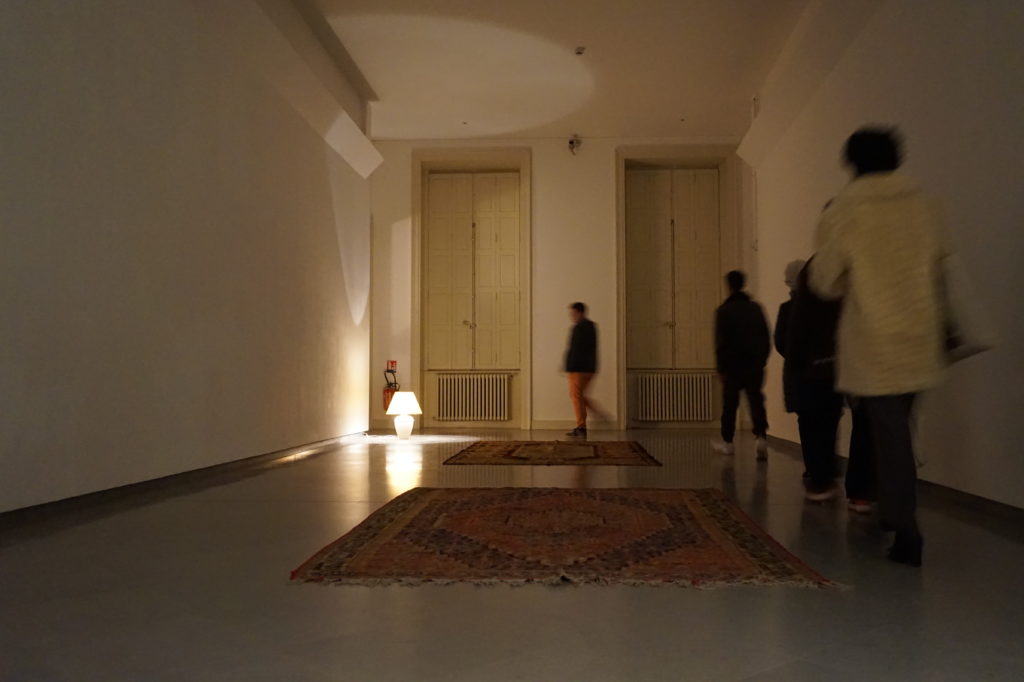
The Master of Fine Art is structured around two main goals:
- the preparation of the final Masters exam: a personal project consisting of a plastic art project that is accompanied by a dissertation ;
- mobility and/or preparation for the student’s integration into professional life

Le Livre d’Image, Jean-Luc Godard, public showing, 2019 
Workshop with the artists Linda Sanchez and Baptiste Croze, 2020 
Les aléas, Baptiste Croze and Linda Sanchez, exhibition at La chapelle des Jésuites, Nîmes 2020.
Specialization in Spatialities
Our specialization in Spatialities aims to help students develop a critical approach for engaging in theoretical and artistic research. It enables them to develop their reflections and gain experience through the study of different kinds of contemporary spatialities that emerge in our daily lives and in various artistic practices, as well as to learn how to transform, act upon, and produce new spatialities.
A transversal approach
Students learn to explore and act upon human interactions with space so they can better perceive what plays out in the space produced by a work of art that is concerned by the place it makes for people. Critically examining spatiality is neither the privilege of the 3-dimensional plastic arts nor of other artistic practices such as dance, theater, cinema, architecture, design, and graphic design nor of art alone.
Adopting a transversal approach makes it possible to complexify the notion of spatiality, to open it up and link it to many of our daily activities, and to the very space in which we live. Drawing on work in the human sciences including anthropology, philosophy, geography, and sociology and the contributions of guest artists and speakers, this specialization aims to help participants comprehend what remains opaque to us and what we ignore. It includes a seminar, workshops, exhibitions, and various encounters and opportunities to engage in discussion with outside speakers including artists, curators, choreographers, philosophers, geographers, anthropologists, and designers.
Specialization in Experimental Forms of Writing
Our specialization in Experimental Forms of Writing gives participants in-depth training in writing based on a transversal approach. Writing is considered from the perspective of its interface with the other arts. It troubles—in the sense of “disturbing”—the languages of cinema and the plastic arts, decentering them in the process. Considering film and performance from a textual point of view, and vice versa, results in movements of translation that alter these languages in ways that create new dimensions.
“Writing as an artist or exploring the plasticity of writing”
This specialization opens a space for reflection and experimentation for uncanny textual and artistic research emblematic of contemporary creation, but which has no proper name or genre, and are also, first and foremost forms of life. Going beyond one frame, these forms do not fully occupy another. They produce displacements and permutations in the borders. Writing as an artist or exploring the plasticity of writing often means working in the fringes. In and across liminal zones. Hollows. Other spaces that must be invented. We create places and means and ways of learning that justify and foster the emergence of such experimental practices.
Students build their project in a setting nurtured by a variety of practices including cinema, literature, and performance. During their two years of specialization, they engage in experimentations that help them define a field of research that is in permanent dialogue with one or more outside disciplines. They compare their languages, observer their porosities, and question the issues raised by the friction between them.
Their research may produce writing for films (voice-over, dialogues…), performance sheets (for readings, plays, dance), particular literary texts (publications, oral and sound creations), and hybrid forms, at the crossroads of verbal, body, and visual language